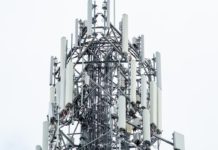In our surroundings, we are exposed on a daily frequency to electric and magnetic fields generated from different common use objects (i.e., power lines, radio and television antennas, household appliances, computers, smartphone …), each one characterized by a different frequency and intensity.
How does these fields interact with the human body?
The electromagnetic fields can be divided into:
- Static low-frequency fields (0Hz- 100 kHz), for example, the ones generated by power lines, household appliances or computers.
- Radiofrequency electromagnetic fields and microwave (100 kHz-300 GHz) , typically generated by telecommunications and broadcasting equipment.
The effects arising from an exposure to electromagnetic fields highly depend on the field strength and frequency (measured in Hertz, this can be identified as the most effective parameter in interaction with humans).
Considering low frequencies, magnetic fields can induce the circulation of eddy currents within themselves (in humans). If sufficiently high, this eddy currents can affect physiological mechanisms, with nerves and, sometimes, muscles stimulation. These acute effects highly depend on the electromagnetic fields strength and arise at the overcoming of threshold values after a limited period and they generally disappear when the stimulus ends. In addition, these effects occurs when the eddy currents reach an intensity comparable to the typical currents of the nervous impulses. Indeed, the nervous system is one of the main targets for this type of interaction and the major effects are related to “false stimulus” as, for example, transient luminous phenomena or phosphenes.
Considering radiofrequency (RF), the fields penetrate the body in small depths and the transported energy is converted into an increase of molecules movement with a consequent increasing in the temperature of the biological tissue (the same effect of heating food in the microwave). The threshold value for thermal effects appearance is known and is adopted as a safety limit. As the effect is linked to the accumulation of heat over time, the reference levels are generally defined as an average over 6 minutes. The levels of the RF fields to which we are daily exposed are much lower than those necessary to produce a significant increase of tissues temperature.
To preserve population and workers from the above described effects, countries establish their own national regulations by implementing international guidelines based on published scientific literature reviews. The International Commission for Non-Ionizing Radiation Protection (ICNIRP) stands out among international institutions and enacted guidelines and indications on the risks related to exposure to electromagnetic fields.
ICNIRP and other institutions have defined the current thresholds for the main low frequency effects and the ‘heating’ limit value, called Specific Absorption Rate (SAR), to be used as a safety limit for thermal effects.
Nevertheless, there is another important issue which has not yet been scientifically solved, that concerns the possibility that chronic exposure to low intensity fields could lead to the development of certain tumor diseases; in particular, since 1979 it has been suggested that there might be a statistical correlation between living near large power lines and childhood neoplastic diseases.
In accordance with this hypothesis, effects due to chronic exposure to field values well below the ones normally considered for the effects described above, have been assumed.
Subsequently, numerous investigations were carried out, many of them in favor of this hypothesis and others, less numerous, negative.
Apart from statistical correlation studies, there is currently no scientific evidence of any mechanism of bioelectromagnetic interaction capable of inducing the above-mentioned effects at low field values.
For this reason, the ICNIRP at the conclusion of the 2010 guidelines, reported:
“The absence of established causality means that this effect cannot be addressed in basic restrictions. However, risk management advice, including considerations on precautionary measures, has been given by WHO (2007a and b) and other entities”, thereby not excluding the utility of precautionary measures.
The International Agency for Research on Cancer (IARC), emanation of the WHO, in 2001 classified magnetic fields at nominal network frequency in group 2B (possible carcinogens), mainly because of the statistical correlation between exposure and childhood leukemia.
In order to better understand the meaning of the IARC classification, one can contemplate the fact that coffee was classified 2B in 1991; following the results of further research (http://www.fondazioneveronesi.it/magazine/articoli/oncologia/caffe-e-tumori-nessun-aumento-del-rischio) in 2016 this classification was withdrawn.
Nowadays, in group 2B, there are “marinated vegetables (traditional of Asia)” while in group 1, corresponding to “carcinogenic to mankind” (http://monographs.iarc.fr/ENG/Classification/index.php) are classified alpha and beta radionuclides but also solar radiation in addition to ultraviolet radiation.
In 2011, the 2B classification was extended to radiofrequency fields, again due to a statistical correlation between acoustic nerve neurinoma and the use of mobile phone. However, IARC itself acknowledges that there is no significant increase in the incidence of this cancer. For this reason too, at the moment the classification is still 2B and not higher.
Italian legislation has tried to address concerns about these effects by mentioning the so-called “Precautionary Principle” in Framework Law 36/2001 and by introducing the values of attention and quality objectives in the 2003 DPCM for the population. The subsequent measures for workers in 2007 and 2008, viceversa, comply with the ICNIRP criteria.The decision of the Supreme Court of Cassation of 17438 of 2012, confirming the judgment of the Court of Appeal of the Court of Brescia Section Labour n. 361/08, for the first time recognized from the legal point of view the causal link between the intensive use of the mobile phone and a trigeminal cancer by introducing a novelty, perhaps internationally, in the jurisprudence. The judgment of the Court of Appeal was based on works published in scientific journals , in previous months.
The publication of the works used also for the justification of the judgment had a great resonance to the point of leading the ICNIRP to publish a partial review of the same (ICNIRP 2011 – ICNIRPSCI review. Mobile phones, brain tumours and the interphone study, where are we now?).
Indeed, IARC extended the 2B classification to radio frequencies in 2011, although the review published by ICNIRP confirmed that the scientific bases for revising the limits were insufficient.
From a scientific point of view, there is no contradiction, since the IARC is not responsible for setting exposure limits, but for indicating the chemical and physical risk agents on which prevention action must be focused.
The scientific work on which the two organizations are based, is largely the same, so it is up to the professionalism of those who use results obtained in fields other than their own not to force the conclusions.
Regulatory references aimed at protecting against the risks of exposure to electromagnetic fields:
– RECOMMENDATION OF THE COUNCIL OF THE EUROPEAN UNION 1999/519 EC “COUNCIL RECOMMENDATION of 12 July 1999 on limiting exposure of the general public to electromagnetic fields from 0 Hz to 300 GHz”:
http://eur-lex.europa.eu/LexUriServ/LexUriServ.do?uri=OJ:L:1999:199:0059:0070:IT:PDF
– LAW 36/2001 “Framework Law on protection from exposure to electric, magnetic and electromagnetic fields”:
http://www.camera.it/parlam/leggi/01036l.htm
– DPCM 8/7/2003 “Establishment of exposure limits, attention values and quality objectives for the protection of the population from exposure to electric and magnetic fields at the network frequency (50 Hz) generated by the power lines. “: http://www.gazzettaufficiale.it/eli/id/2003/08/29/03A09749/sg
– DIRECTIVE 2004/40/EC OF THE EUROPEAN PARLIAMENT AND OF THE COUNCIL of 29 April 2004 on the minimum safety and health requirements relating to the exposure of workers to the risks arising from physical agents (electromagnetic fields):
http://eur-lex.europa.eu/LexUriServ/LexUriServ.do?uri=OJ:L:2004:159:0001:0026:IT:PDF
– Dlgs 81/2008 Legislative Decree 9 April 2008, n. 81 “Implementation of Article 1 of Law 3 August 2007, n. 123, on the protection of health and safety in the workplace”
http://www.camera.it/parlam/leggi/deleghe/08081dl.htm
– DIRECTIVE 2013/35/EU OF THE EUROPEAN PARLIAMENT AND OF THE COUNCIL of 26 June 2013 on the minimum health and safety provisions relating to the exposure of workers to the risks arising from physical agents (electromagnetic fields) (20th individual Directive within the meaning of Article 16 paragraph 1 of Directive 89/391/EEC) and repealing Directive 2004/40/EC:
http://eur-lex.europa.eu/LexUriServ/LexUriServ.do?uri=OJ:L:2013:179:0001:0021:IT:PDF






